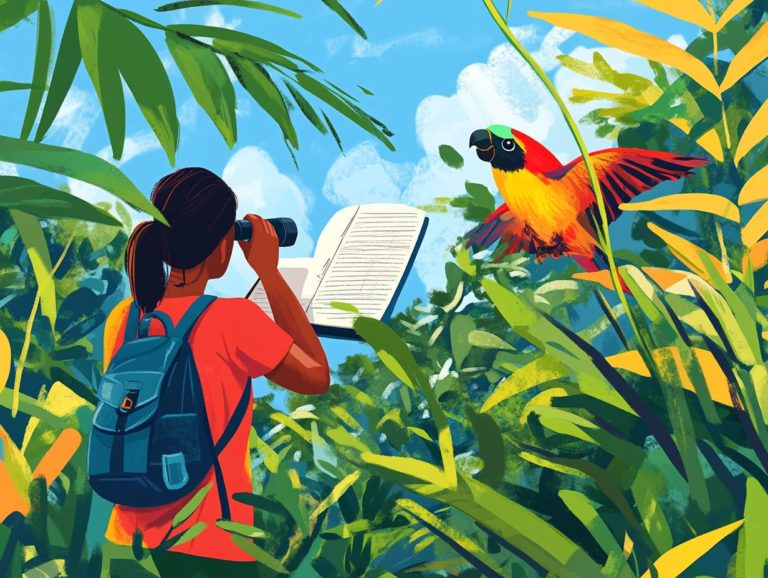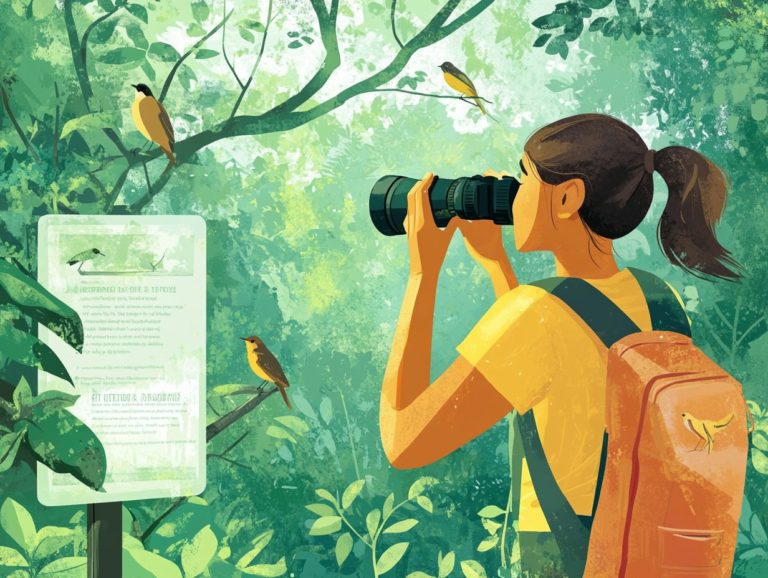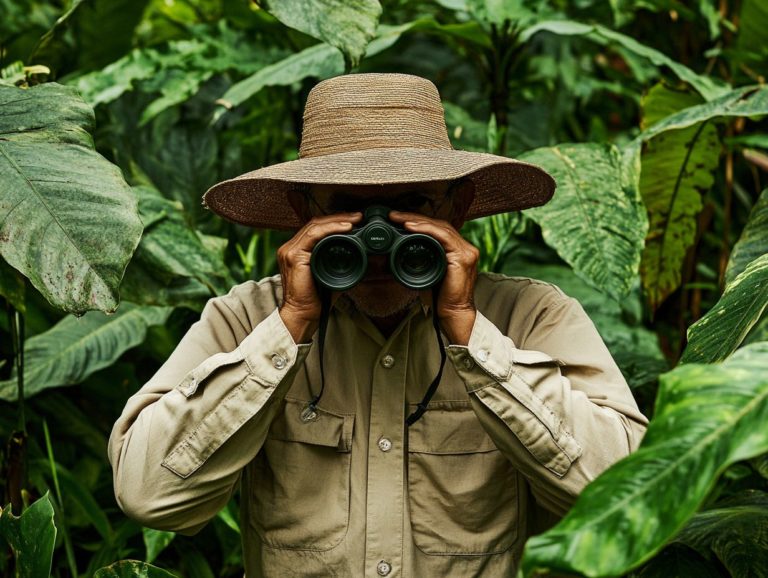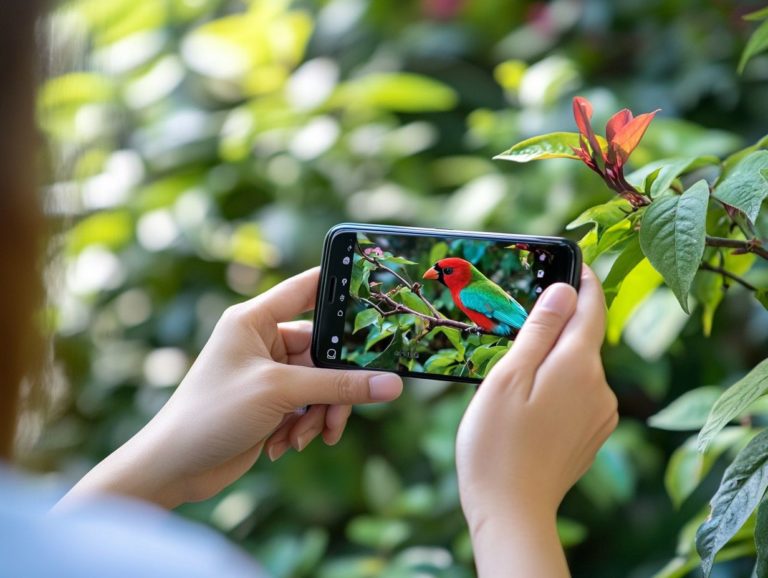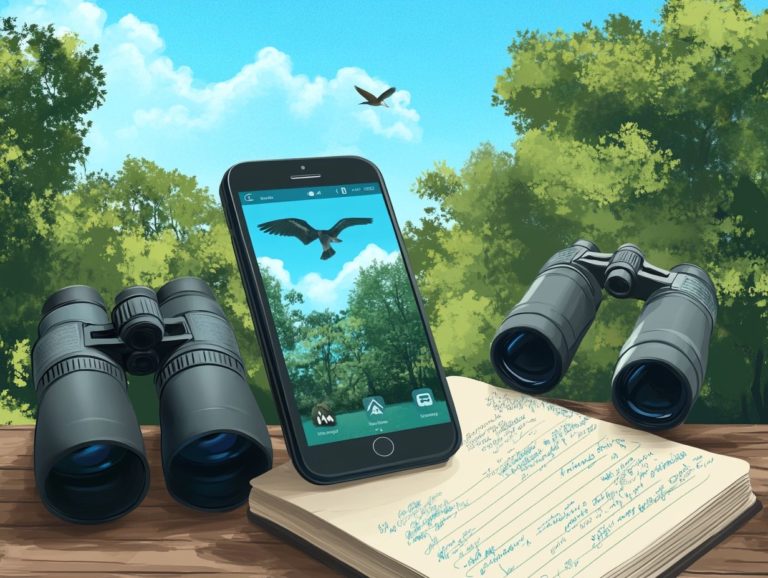How Does Bird Watching Help with Environmental Conservation?
We need effective conservation strategies now more than ever! This article shows how birdwatching connects to environmental conservation and highlights how observing birds can enhance our understanding and appreciation of nature.
Birdwatching enriches our lives and helps protect our environment by supporting citizen science projects that monitor the health of bird populations.
This article outlines the benefits of birdwatching and offers suggestions on how to get started.
Contents
- Key Takeaways:
- The Importance of Environmental Conservation
- Birdwatching as a Tool for Conservation
- Benefits of Bird Watching for Conservation
- How to Get Started with Bird Watching for Conservation
- Frequently Asked Questions
- What is bird watching and how does it relate to environmental conservation?
- How does bird watching contribute to the protection of bird species?
- Can bird watching help with the conservation of other species besides birds?
- How does bird watching promote sustainable tourism?
- How can children benefit from bird watching in terms of environmental conservation?
- What are some simple ways that bird watchers can help with environmental conservation?
Key Takeaways:
- Birdwatching is more than just a hobby – it can be a powerful tool for conservation.
- By observing birds, you can develop a personal connection and understand the importance of protecting our environment.
- Join local groups and participate in citizen science projects to actively contribute to conservation efforts.
The Importance of Environmental Conservation
Environmental conservation is vital for preserving biodiversity and ecosystem services while meeting the needs of future generations.
With rising issues like climate change and species decline, conservation efforts are increasingly essential to protect our natural surroundings.
These efforts include community engagement activities that foster a deeper connection to nature, recognize the intrinsic value of wildlife protection, and adopt sustainable practices that benefit both the environment and our mental and physical well-being.
Why We Need to Protect Our Environment
Protecting our environment is crucial for maintaining healthy ecosystems and fostering strong communities, as it significantly impacts mental health, physical health, and the economy.
Mental Health: Children who play outside exhibit lower levels of anxiety and depression, effectively countering the nature deficit disorder that has surged in recent years. Research shows that outdoor experiences enhance well-being and foster a long-term appreciation for nature.
Physical Health: Outdoor play contributes to lower obesity rates among children, as they tend to be more active outside. Studies from the U.S. Department of Health and Human Services reveal that outdoor play involves various activities, including biking, tag, and running, at rates three to four times higher than indoor play. This increased activity leads to healthier weights and better cardiovascular health.
Lower obesity rates in children also lead to healthier adults, enhancing overall community health.
Economic Health: Conservation significantly impacts the economy. A report from the U.S. National Oceanic and Atmospheric Administration indicates that every dollar spent on conserving coastal and marine areas yields nearly $4 in economic value. Successful initiatives, such as community parks showcasing local species, not only conserve biodiversity but also attract wildlife recreationists. This highlights the connection between environmental stewardship and economic progress.
Birdwatching as a Tool for Conservation
Birdwatching serves as a vital tool for conservation by fostering an appreciation for the diverse range of bird species. It allows individuals to participate in citizen science projects, helping scientists collect valuable data on wildlife.
How Observing Birds Can Help the Environment
Bird observation plays a crucial role in identifying population trends and species loss. These factors are essential for effective habitat conservation and wildlife protection measures.
Through point counts, monitored banding, and citizen science projects, birdwatching enthusiasts worldwide collect vast amounts of data related to bird populations. This data enables researchers to track shifts in bird distribution and population numbers, serving as an important indicator of ecosystem health.
The records kept by birdwatchers are vital for conservationists. They help determine where to prioritize protection efforts.
Awareness of how birds and their habitats are connected inspires community involvement, which is key to promoting action for biodiversity protection. This ensures that future generations can enjoy the diverse ecosystems and wildlife that surround them.
Benefits of Bird Watching for Conservation
Birdwatching offers numerous benefits for conservation, such as fostering personal connections to nature and raising awareness of environmental issues through community engagement.
Personal Connection and Awareness
Birdwatching enhances mental health by fostering a connection with nature. This connection is essential for engaging youth in outdoor activities.
These experiences promote an appreciation for the environment and strengthen social bonds among participants, creating a sense of community.
Studies indicate that children who participate in outdoor activities like birdwatching are 20% less likely to report feelings of anxiety and depression compared to those who primarily stay indoors. This hobby encourages physical activity, leading to improved overall well-being.
By nurturing these connections, young people develop a love for nature, learn the value of friendships and teamwork, and become more motivated to explore the outdoors together.
Contributing to Citizen Science
Citizen science projects like eBird and the Big Garden Birdwatch offer birdwatchers the opportunity to contribute to conservation efforts. By reporting their observations of different bird species, they become part of a larger network dedicated to data collection that informs conservation initiatives.
Join thousands of bird lovers and see your data make a difference! For instance, eBird boasts over a billion bird observations from around the globe, offering real-time insights into the distribution and trends of various species.
This information is crucial for predicting changes in bird populations due to climate change and habitat destruction.
The Big Garden Birdwatch engages thousands of families, illustrating how even small contributions can lead to significant outcomes—such as improved habitat management and targeted protection efforts for endangered species.
How to Get Started with Bird Watching for Conservation
Birdwatching for conservation necessitates minimal equipment and techniques, highlighting the significance of birding clubs and outdoor enthusiasts.
Equipment and Techniques
Essential equipment for birdwatching includes:
- High-quality binoculars
- Field guides for bird identification
Both of these enhance the overall experience of birdwatching and outdoor activities.
When selecting binoculars, the appropriate magnification and the size of the lens are crucial for observing birds in their natural environment. As a general guideline, binoculars with an 8×42 magnification provide good detail while maintaining an adequate field of view, making them an excellent choice for birdwatching.
Pairing these tools with reliable field guides facilitates the identification of species based on their distinctive features, such as feather patterns and songs.
To develop identification skills, aspiring birdwatchers should practice with local species, attend guided walks, and participate in community events. Engaging with others who share the same passion greatly enriches the field experience, offering opportunities to exchange knowledge and tips that can deepen one’s understanding of bird behavior.
Grab your binoculars and join a local birdwatching club today!
Joining Local Groups and Initiatives
Joining local birding clubs and initiatives fosters community involvement and engages youth in conservation efforts through organized outdoor activities. These clubs offer a wealth of resources and opportunities for individuals to learn and grow as conservationists, including workshops, guided birdwatching trips, and educational materials.
For instance, the National Audubon Society and its local chapters often run programs that allow young people to participate in field-based conservation efforts. This helps to cultivate a lifelong love of nature. Participation in these clubs equips youth with practical skills while contributing to habitat restoration and wildlife monitoring, ultimately creating knowledgeable guardians within their communities.
Joining birding clubs builds a strong sense of community and shared responsibility for protecting local birds and their habitats.
Frequently Asked Questions
What is bird watching and how does it relate to environmental conservation?
Bird watching is the activity of observing and identifying birds in their natural habitats. It closely relates to environmental conservation as it promotes awareness and appreciation of birds and their habitats, which are vital components of a healthy ecosystem.
How does bird watching contribute to the protection of bird species?
Through bird watching, individuals can collect valuable data on bird populations and their behaviors. Conservation organizations use this information to develop effective strategies for protecting threatened and endangered bird species.
Can bird watching help with the conservation of other species besides birds?
Absolutely! Bird watchers are often interested in other wildlife and their habitats. Engaging in bird watching fosters a deeper understanding and appreciation for the natural world, leading to a more holistic approach to environmental conservation.
How does bird watching promote sustainable tourism?
Bird watching enthusiasts frequently travel to different locations to observe and photograph birds. This supports local economies and encourages the conservation of natural habitats, as preserving bird habitats is essential for maintaining bird populations and attracting tourists.
How can children benefit from bird watching in terms of environmental conservation?
Bird watching can be a fun and educational activity for children. It allows them to learn about different bird species and their habitats. Fostering a love for birds and nature increases the likelihood that children will grow up to become environmentally conscious individuals who contribute to conservation efforts.
What are some simple ways that bird watchers can help with environmental conservation?
Aside from collecting data and supporting conservation organizations, bird watchers can participate in citizen science projects. They can also adopt sustainable practices while birding, such as using binoculars instead of disturbing birds, and educate others about the importance of bird conservation.
Join the adventure of bird watching and let’s protect our feathered friends together!

